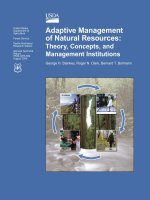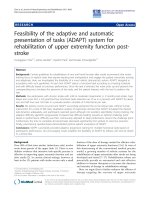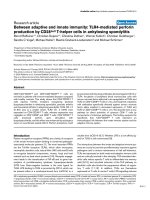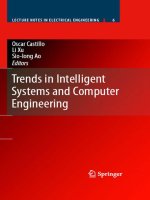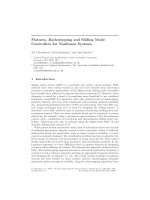adaptive and intelligent controller
Bạn đang xem bản rút gọn của tài liệu. Xem và tải ngay bản đầy đủ của tài liệu tại đây (462.79 KB, 8 trang )
ADAPTIVE AND INTELLIGENT CONTROLLER
USING NEURAL NETWORK
Tu Diep Cong Thanh * and Kyoung Kwan Ahn **
* Mechatronics Department, HCMC University of Technology, Viet Nam
** School of Mechanical and Automotive Engineering, University of Ulsan, Korea
ABSTRACT
Intelligent control techniques have emerged to overcome some deficiencies in conventional
control method in dealing with complex real-world systems. These problems include knowledge
adaptation, learning and expert knowledge incorporation. In this paper, a newly proposed intelligent
controller which includes both neural network controller as compensator and an intelligent switching
control algorithm based on learning vector quantization neural network (LVQNN) is used to control of
complex dynamic systems. A superb mixture of conventional PID controller and the neural network’s
powerful capability of learning, adaptive and tackle nonlinearity bring us a good-tracking controller
for such a kind of plants with high nonlinearity and hysteresis. In addition, with the greatly changing
external environments, a learning vector quantization neural network (LVQNN) is applied as a
supervisor of the conventional PID controller, which estimates the external environments and switches
to the optimal gain of the PID controller.
Results of simulating on the complex dynamic systems such as pneumatic artificial muscle (PAM)
manipulator show that the newly proposed intelligent controller presented in this study can making
online control with better dynamic property, strong robustness and suitable for the control of various
plants, including linear and nonlinear process and without regard to the severe change of external
environments.
1. INTRODUCTION
Staring with linear control techniques, the
strategy of PID control has been one of the
sophisticated methods and most frequently used
in the industry due to its simple architecture,
easy tuning, cheap and excellent performance
[1][2]. However, the requirement of control
precision becomes higher and higher, as well as
the plants become more and more complex.
Hence, the conventional PID controller with
fixed parameters may usually deteriorate the
control performance. Various types of modified
PID controllers have been developed such as an
adaptive/self-tuning PID controller [3], self-
tuning predictive PID controller [4], and so on.
Though satisfactory performance can be
obtained and the proposed controllers above
provide better response, command following
and greater bandwidth than the conventional
PID control method, these controllers are
limited because of the limitation of capability of
learning algorithm and step by step tuning
control parameters without automatically.
More recently neural networks have been
used to implement intelligent control systems. It
is anticipated that the combination will take
advantage of simplicity of PID control and the
neural network’s powerful capability of
learning, adaptability and tackling nonlinearity.
There are multitude of PID controllers based on
neural networks with various kinds of structures
and learning algorithms. The position controller
based on PID controller and neural networks
was used [5]. Nonlinear PID controller using
neural networks to improve dynamic properties
of complex system was proposed by Matsukuma
and his team [6]. Although these intelligent
controllers can control the nonlinear systems
with high performance, it is difficult to analyze
the control systems and in particular, the
external environment problems were assumed to
be constant or slowly varying. With greatly
changing external environments, an intelligent
PID controller with a neural supervisor had been
tried [7]. However, any con troll algorithm
introduced up to now was proved that the
control performance becomes deteriorated with
respect to the abruptly and greatly changing
external environments.
To overcome these problems, a newly
proposed intelligent controller which includes
both neural network controller as compensator
and an intelligent switching control algorithm
based on learning vector quantization neural
network (LVQNN) is used to control of
complex dynamic systems without regard to
greatly changing external environments.
A superb mixture of conventional PID
controller and the neural network’s powerful
capability of learning, adaptive and tackle
nonlinearity bring us a good-tracking controller
for such a kind of plants, which are high
nonlinearity and hysteresis. In addition, with the
greatly changing external environments, a
learning vector quantization neural network
(LVQNN) is applied as a supervisor of the
conventional PID controller, which estimates the
external environments and switches to the
optimal gain of the PID controller.
Results of simulating on the complex
dynamic systems such as pneumatic artificial
muscle (PAM) manipulator show that the newly
proposed intelligent controller presented in this
study can make online control with better
dynamic property, strong robustness and
suitable for the control of various plants,
including linear and nonlinear process and
without regard greatly changing external
environments.
2. INTELLIGENT CONTROL
ALGORITHM
2.1 The overall control system
Figure 1 shows the overall structure of the
newly proposed intelligent control algorithm.
The proposed algorithm consists of a neural
network controller, which is installed in parallel
with conventional PID controller and an
intelligent switching control algorithm in order
to estimate the external environments and switch
to the optimal gain of the PID controller.
A conventional PID control algorithm is applied
in this paper as the basic controller. The
controller output can be expressed in the time
domain as:
∫
++=
t
dp
i
p
pf
dt
tde
TKdtte
T
K
teKtu
0
)(
)()()(
(1)
Taking the Laplace transform of (1) yields:
)()()()( ssETKsE
sT
K
sEKsU
dp
i
p
pf
++= (2)
The resulting PID controller transfer function of:
⎟
⎟
⎠
⎞
⎜
⎜
⎝
⎛
++= sT
sT
K
sE
sU
d
i
p
f
1
1
)(
)(
(3)
A typical real-time implementation at sampling
sequence k can be expressed as:
T
keke
TK
ke
T
TK
kukeKku
dp
i
p
pf
)1()(
)()1()()(
−−
+
+−+=
(4)
)()()( kxkyke
−
=
(5)
where
)(ku
f
,
)(ke
,
)(ky
and
)(kx
are the
output of conventional PID controller, the error
between the desired set point and the output, the
desired set point and the output, respectively.
From Fig. 1, the control input to plant can be
computed as follow:
)()()( kukuku
Nf
+
=
(6)
where
)(ku
N
is the modify-output of neural
network controller.
Fig. 1 Structure of the newly proposed
intelligent control algorithm
2.2 Neural network controller
In order to overcome the limitation of the
conventional PID controller and improve its
property, a neural network controller is installed
in parallel with conventional PID controller as
compensator. Neural network controller can
represent any nonlinear function, and has self-
learning and parallel processing abilities as well
as strong robustness and fault-tolerance, so it fits
for online adaptive control with PID controller.
Conventional PID controller contributes to
ensuring the stability of the system at the
beginning of learning and neural networks
controller adds the adaptability for variations of
operational conditions. With the progress of
learning, the output from linear controller
decreases and the neural networks controller
becomes to dominate the overall control system.
The control error
)(ke is used as a teaching
signal to be minimized.
2.2.1 Structure of neural network controller
Figure 2 shows the structure of neural network
controller. The input layer has seven neurons
including a neuron with output of –1 to set the
bias value of each neuron in hidden layer. There
are fourteen neurons including a neuron with –1
in hidden layer. All layers are connected in only
the forward direction. The input to each neuron
is given as the weighted sum of outputs from the
previous layer. The output of each neuron is
generated by linear function in the input layer,
in hidden and output layers the sigmoid function
is used.
x
sigmoid
e
xf
−
+
=
1
1
)(
(7)
2.2.2 Leaning algorithm
In Fig. 2, the following symbols are defined:
I
j
i
: Input to the j
th
neuron in the input layer
I
j
o :Output from the j
th
neuron in the input layer
H
k
i
: Input to the k
th
neuron in the hidden layer
H
k
o :Output of the k
th
neuron in the hidden layer
O
i
: Input to the output layer
O
o : Output from the output layer
IH
jk
ω
: Weight from the jth neuron in the input
layer to the kth neuron in the hidden layer
HO
k
ω
: Weight from the kth neuron in the hidden
layer to the output layer
The modify-output of neural network controller
can be expressed as following equation
(
)
5.0−=
O
nN
oKu (8)
n
K
: Proportional gain of the output of neural
network controller
The operation of each neuron is described as:
I
j
I
j
io = (9)
∑
==
j
I
j
IH
jk
H
k
H
ksigmoid
H
k
oiifo
ω
),( (10)
∑
==
k
H
k
HO
k
OO
sigmoid
O
oiifo
ω
),(
(11)
The leaning process is based on the back
propagation algorithm, which minimizes E
given by:
()
2
2
2
1
2
1
eyxE =−=
(12)
The weights are updated by the following
increments to minimize E:
IH
jk
IH
jk
E
ω
ηω
∂
∂
×−=∆ (13)
HO
k
HO
k
E
ω
ηω
∂
∂
×−=∆ (14)
where
0>
η
is learning rate to determine the
speed of leaning.
HO
k
E
ω
∂
∂
in Eq. (14) can be calculated by:
HO
k
O
OHO
k
i
i
EE
ωω
∂
∂
∂
∂
=
∂
∂
(15)
H
k
k
H
k
HO
k
HO
k
HO
k
O
oo
i
=
⎟
⎠
⎞
⎜
⎝
⎛
∂
∂
=
∂
∂
∑
ω
ωω
(16)
O
O
i
E
δ
−=
∂
∂
(17)
H
k
O
HO
k
o
E
×−=
∂
∂
δ
ω
(18)
O
δ
is called a generalized error calculated by:
O
O
O
O
i
o
o
y
y
E
∂
∂
∂
∂
∂
∂
−=
δ
(19)
()
eyx
yy
E
−=
⎟
⎠
⎞
⎜
⎝
⎛
−
∂
∂
=
∂
∂
2
2
1
(20)
)(
)(
' O
sigmoid
O
O
sigmoid
O
O
if
i
if
i
o
=
∂
∂
=
∂
∂
(21)
The dynamic of the controlled plant is not
considered to calculate
O
o
y
∂
∂
assumed to be
constant.
constC
o
y
O
==
∂
∂
(22)
The increment of weight can be written as:
H
k
O
HO
k
HO
k
o
E
××=
∂
∂
×−=∆
δη
ω
ηω
(23)
Consequently, the weight is updated by:
H
k
O
sigmoid
HO
k
H
k
OHO
k
HO
k
oifCe
o
××××+
=××+=
)(
'
ηω
δηωω
(24)
The update equation, Eq. (25) of the weight
IH
jk
ω
can be derived in the same manner.
I
j
H
k
IH
jk
IH
jk
o××+=
δηωω
(25)
where,
)()(
'' H
ksigmoid
HO
k
O
sigmoid
H
k
H
k
H
k
O
O
O
O
H
k
ififCe
i
o
o
i
i
o
o
y
y
E
××××
=
∂
∂
∂
∂
∂
∂
∂
∂
∂
∂
−=
ω
δ
(26)
With the learning of the neural network and the
decreasing of the error, the neural networks
works more and more effective until it
completely compensates the deficiency of the
conventional PID controller. The structure and
the learning algorithm of the network are
relative simple and the physical meaning of the
input and outputs is clear. The effectiveness of
the proposed controller is investigated through
the simulation of the complex dynamic systems
such as PAM manipulator.
2.3 An intelligent switching control algorithm
Problems with control the complex dynamic
systems without regard greatly changing
external environments is briefly discussed in this
section. The variation external environments
must be recognized for an intelligent control of
the complex dynamic systems. Here, the
learning vector quantization neural network
(LVQNN) is proposed as a supervisor of the
intelligent switching control algorithm.
Fig. 2 Structure of neural network controller
2.3.1 Structure of the neural classifier
According to the learning process, neural
networks are divided into two kinds: supervised
and unsupervised. The difference between them
lies in how the networks are trained to recognize
and categorize objects. The LVQNN is a
supervised learning algorithm, which was
developed by Kohonen and is based on the self-
organizing map (SOM) or Kohonen feature
map. The LVQNN methods are simple and
effective adaptive learning techniques. They rely
on the nearest neighbor classification model and
are strongly related to condensing methods,
where only a reduced number of prototypes are
kept from a whole set of samples. This
condensed set of prototypes is then used to
classify unknown samples using the nearest
neighbor rule. The LVQNN has a competitive
and linear layer in the first and second layer,
respectively. The competitive layer learns to
classify the input vectors and the linear layer
transforms the competitive layer’s classes into
the target classes defined by the user. Figure 3
shows the architecture of the LVQNN, where P,
y, W1, W2, R, S1, S2, and T denote input
vector, output vector, weight of the competitive
layer, weight of the linear layer, number of
neurons of the input layer, competitive layer,
linear and target layer, respectively. In the
learning process, the weights of the LVQNN are
updated by the following Kohonen learning rule
if the input vector belongs to the same category.
)),()()((),(
111
jiWjpiajiW
−
=
∆
λ
(27)
If the input vector belongs to a different
category, the weights of the LVQNN are
updated by the following rule:
)),()()((),(
111
jiWjpiajiW −
−
=
∆
λ
(28)
where λ is the learning ratio and
)(
1
ia
is the
output of the competitive layer.
2.3.2 Data generation for the training of the
LVQNN
In the design of the LVQNN, it was very
important to identify what input to select and
how many sequences of data to use. Generally
the training result was better according to the
increase of the number of input vectors, but it
took more calculation time and the starting time
of the recognition of inertia load was later. In
our simulation, in order to recognize the
variation external environments, the control
input and system response are utilized to input
vectors as shown in Fig. 4. The output of the
LVQNN is an integer value, which is
represented for the recognized-class. In our
research works, 3 kinds of the environments are
used, which are variation from high stiffness to
low stiffness, and are called environment 1,
environment 2 and environment 3, respectively.
With respect to each environment, the outputs of
the LVQNN are also called class 1, class 2, and
class 3, respectively.
To obtain the learning data for the LVQNN, a
series of experiments were conducted under 3
different external environments. With each
environment, it just only has one PID controller,
which is suitable to. That means there are 3
controllers (PID Controller 1, PID Controller 2
and PID Controller 3), which are suitable with 3
kinds of the environments one by one. And then,
the generation of training data is shown in Fig. 5
and 6, which correspond to the control input to
the system, and system response, respectively.
To obtain the generation of training data, the
control parameters of the PID controllers are
obtained through trial-and-error, which are
shown in Table 1. From Table 1, it was
understood that the proportional, integral and
derivative control gains were increasing in
accordance with a decrease in the stiffness of the
external environments.
2.3.3 Training process of the LVQNN
The learning vector quantization neural network
(LVQNN) is a method for training competitive
layers in a supervised manner. A competitive
layer will automatically learn to classify input
vectors. However, the classes that the
competitive layer finds are dependent only on
the distance between input vectors. If two input
vectors are very similar, the competitive layer
probably will put them into the same class.
Thus, the LVQNN can classify any set of input
vectors, not just linearly separable sets of input
vectors. The only requirement is that the
competitive layer must have enough neurons,
and each class must be assigned enough
competitive neurons.
A total of 9 simulation cases were carried out to
prepare for the generation of training data for
the LVQNN. In the training stage of LVQNN,
the number of input vectors were adjusted from
4 to 22 with 10 steps and the number of neurons
in the competitive layer were adjusted from 10
to 28 with 10 steps, as shown in Table 2, in
order to obtain the optimal weight of the
LVQNN. To investigate the classification ability
of the LVQNN, the same input vectors, which
were used in the learning stage, were re-entered
into the LVQNN and the learning success rate
was calculated. Here, the learning success rate
defines the percentage of success of the
LVQNN learning, where success means that the
output of the LVQNN was equal to the target
class with respect to the same input vectors.
Fig. 3 Structure of the LVQNN
Fig. 4 Learning data for the LVQNN
As the LVQNN classified input vectors into
target classes by using a competitive layer and
the classes that the competitive layer found were
dependent only on the distance between input
vectors, a high learning success rate was
0.0 0.5 1.0 1.5 2.0
10
20
30
40
50
60
Control Input
Time [s]
(a)
Environment 1
PID Controller 1
PID controller 2
PID controller 3
0.0 0.5 1.0 1.5 2.0
100
200
300
400
500
600
700
800
Control Input
Time [s]
(b)
Environment 2
PID Controller 1
PID controller 2
PID controller 3
0.0 0.5 1.0 1.5 2.0
500
1000
1500
2000
2500
3000
3500
4000
Control Input
Time [s]
(c)
Environment 3
PID Controller 1
PID controller 2
PID controller 3
0.0 0.5 1.0 1.5 2.0
0
10
20
30
System Response
Time [s]
(a)
Environment 1
Reference
PID Controller 1
PID controller 2
PID controller 3
0.0 0.5 1.0 1.5 2.0
0
10
20
30
System Response
Time [s]
(b)
Environment 2
Reference
PID Controller 1
PID controller 2
PID controller 3
0.0 0.5 1.0 1.5 2.0
0
10
20
30
System Response
Time [s]
(c)
Environment 3
Reference
PID Controller 1
PID controller 2
PID controller 3
Fig. 5 Simulation
results for learning
data generation of
control input
Fig. 6 Simulation
results for learning
data generation of
system response
realized when the input vectors were distributed
widely.
From Fig. 7, it was also understood that the
optimal number of input vectors and neurons of
the competitive layer were chosen to be 14 and
20, respectively and the maximum training
success rate was 97[%], which was enough for
recognition of the external environments.
Fig. 7 Training success rate of the LVQNN
2.4 Proposition of the smooth switching
algorithm
If the external environment was different from
the previous training condition, the output of the
LVQNN may have belonged to the mixed
classes with different ratios in each case (i.e. if
the external environment between environment
1 and environment 2, it may have belonged to 1
or 2 class). Therefore the following switching
algorithm was proposed to apply to the abrupt
change of class recognition result. The
switching algorithm is described by the
following equation:
)()1(
)1()(
kclass
kclasskclass
×−+
−×=
α
α
(29)
where
k is the discrete sequence,
α
is the
forgetting factor and
)(kclass is the output of
the LVQNN at the
k
time sequence.
3. SIMULATION RESULTS
To investigate the newly proposed intelligent
control algorithm, the simulation on the
complex dynamic systems such as pneumatic
artificial muscle manipulator is carried out. As a
novel actuator, which has been regarded during
the decades as an interesting alternative to
hydraulic and electronic actuators, the PAM
actuator has been applied to many industrial
applications as well as researching on modeling
and control.
Among previous works, as done by Osuka and
his team [8], the nominal plant model of PAM
manipulator was obtained as follow:
27.889374.23
27.889
)(
2
+
+
=
s
sG
(30)
In my study, 3 kinds of environments with
variation stiffness were assumed as below:
27.889374.23
27.889
)(
2
+
+
×
=
s
k
sG
k
(31)
where
1
=
k
,
1.0
=
k
and
01.0=k
with
respect to high stiffness, normal stiffness and
low stiffness, respectively.
Firstly, the effectiveness of newly proposed
intelligent control algorithm is demonstrated
through simulation with respect to high stiffness
environment. In simulation, the proportional
gain of output of neural network controller,
n
K ,
and learning rate of neural network
controller,
η
, are set to be 1100 and 0.01,
respectively. These control parameters are
obtained through trial-and-error. The initial
values of weights from the input layer to the
hidden layer,
IH
jk
ω
, and that of weights from the
hidden layer to the output layer,
HO
k
ω
, of the
neural network are given by random numbers
from –0.1 to 0.1. As also, the control parameters
of PID controller 1 are used in this case. Figure
8 shows the comparison between conventional
PID controller 1 and the proposed controller in
case considering the effectiveness of neural
network controller as compensator. That means,
in this case, the effectiveness of an intelligent
switching control algorithm is not applied yet.
From Fig. 8, it is clear that the complex
dynamics, high nonlinearity and hysteresis have
been handled. The system response with the
proposed control algorithm is very agreement
with the desired set point. In addition, it is
obvious that the proposed controller plays the
main role at the beginning of the control
process. After the neural network controller is
consistently trained through error, it gradually
compensates the deficiency of the conventional
PID controller. This is a controlling and learning
process with the ability of adapting the changing
of the complex dynamic systems such as PAM
manipulator.
Figure 9 shows the simulation results of system
response with variation external environments
(k=1, k=0.1 and k=0.01), where the PID control
gains were fixed and the same as that of the high
stiffness environment. From Fig. 9, it was
understood that the system response became
worse according to the decrease of the stiffness
and it was requested that the control parameters
of PID controller be adjusted according to the
change of the external environments.
Next, simulations were carried out to verify the
effectiveness of the proposed intelligent control
algorithm. In this case, the proportional gain of
output of neural network controller,
n
K
, with
respect to 3 kinds of the external environments
from high stiffness to low stiffness are set to be
1100, 7500, and 45000, respectively. As also,
proposition of the smooth switching algorithm is
applied in this situation. And the forgetting
factor,
α
, is set to be 0.6. These control
parameters are obtained through trial-and-error.
In order to demonstrate the effectiveness of the
newly proposed intelligent control algorithm,
the initial control parameters of PID controller 1
are used. That means the control parameters of
PID controller 1 are set for all simulation
without regard the external environments. After
a few milliseconds, when the data is enough for
recognizing the external environment by the
LVQNN, the control parameters of PID will be
auto-tuning by proposition smooth switching
algorithm and the result from recognition class
of the LVQNN. The simulation results are
shown in Fig. 10, 11 and 12, which correspond
to the high stiffness environment, normal
stiffness environment, and low stiffness
environment, respectively. In these figures, we
show system response, control input, output of
neural network controller and output of the
LVQNN in case proposition smooth switching
algorithm is applied, respectively. The number
of the input vector was 14, which included 7
control inputs and 7 system response outputs.
From these simulation results, particularly in the
output of the LVQNN, it was verified that the
external inertial load was almost exactly
recognized to the correct class and an accurate
control performance was obtained without
regard the greatly changing external
environments.
The simulation results, which the external
environment is between class 2 and class 3
(k=0.004), are shown in Fig.13. In this case, the
proportional gain of output of neural network
controller is
1000=
n
K . From Fig. 13, the
class number calculated from the output of the
LVQNN was between 2 and 3, which proved
that the external environment was between
k=0.1 and k=0.01. In Fig. 14, 15 and 16,
simulations were conducted to compare the
system response with respect to 3 different
external environments (k=0.1, k=0.01 and
k=0.04) with and without the proposed
intelligent control algorithm using neural
networks. As also, in these figures, the
comparison between proposed controller and the
conventional PID controller with respect to
correctly of that environment. From the
simulation results, it was found that the system
response became worse according to decrease in
the stiffness of external environment without
auto-tuning adaptively control parameters of
PID controller. On the contrary, the system
response was almost the same in any case by
using the newly proposed intelligent control
algorithm. To compare with the conventional
PID controller with respect to correctly of that
environment, it was also verified that the
proposed method was very effective in the
accurate control of the PAM manipulator.
4. CONCLUSION
In this study, the newly proposed intelligent
control algorithm using neural network are
given. It is strongly recommended that the
proposed control algorithm is very effective in
both handling the high nonlinearity, hysteresis
and without regard the greatly changing external
environments.
The newly intelligent controller presented can
making online control with better dynamic
property, strong robustness and suitable for the
control of various kinds of complex dynamic
systems.
A more essential factor is that the proposed
controller is easy applied to both accurate
position control and force-control of various
plants, including linear and nonlinear process
and without regard greatly changing external
environments.
Table 1 Optimal parameters of the PID
controller
Environments Kp Ki Kd
1 100 10 5
2 300 200 30
3 1200 1000 200
Fig. 16 Comparison of the simulation results
with and without proposed intelligent controller
with respect to environment between 2 and 3
REFERENCES
1. Bennett, S., “Development of the PID
controller,” in IEEE, Control Systems
Magazine, Vol. 13 (1993), pp. 58~62.
2. Hamdan, M. and Zhiqiang Gao,“A novel PID
controller for pneumatic proportional valves
with hysteresis,” in IEEE Int., Conf., Industry
Applications, Vol. 2 (2000), pp. 1198~1201.
3. Grassi, E., Tsakalis, K.S., Dash, S., Gaikwad,
S.V., and Stein, G., “Adaptive/self-tuning PID
control by frequency loop-shaping,” in Proc.,
IEEE Int., Conf., Decision and Control, Vol. 2
(2000), pp. 1099~1101.
4.Vega, P., Prada, C., Aleixander, V., “Self-
tuning predictive PID controller,” in IEE Proc.,
Vol. 3 (1991), pp. 303~311.
5. Choi, G.S., Lee, H.K., and Choi, G.H., 1998,
“A study on tracking position control of
pneumatic actuators using neural netw,” in
Proc., IEEE Int., Conf., Industrial Electronics
Society, Vol. 3 (1998), pp. 1749~1753.
6. Matsukuma, T., Fujiwara, A., Namba, M.,
and Ishida, Y., “
Non-linear PID controller
using neural networks,” Int., Conf.,
Neural
Networks, Vol. 2 (1997) , pp. 811~814.
7. Oki, T., Yamamoto, T., Kaneda, N., and
Omatsu, S., 1997, “
An intelligent PID
controller with a neural supervisor,” in IEEE
Int., Conf.,
Systems, Man, and Cybernetics,
Vol. 5 (1997), pp. 4477~4482.
8. Osuka, K., Kimura, T., Ono, T., “H∞ control
of a certain nonlinear actuator,” in Proc., IEEE
Int., Conf., Decision and Control, Honolulu,
Hawai, Vol. 1 (1990), pp. 370~371.
0.0 0.5 1.0 1.5 2.0
0
10
20
30
System Response
Time [s]
Environment 1
Reference
Proosed Intelligent Controller
PID controller 1
Fig. 8 Comparison of
the simulation results
with and without neural
network controller
0.0 0.5 1.0 1.5 2.0
0
10
20
30
40
System Response
Time [s]
PID Controller 1
Reference
Environment 1
Environment 2
Environment 3
Fig. 9 Simulation
results of system
response with variation
external environments
0.0 0.5 1.0 1.5 2.0
1.0
1.5
Time [s]
Output of
the LVQNN
-10
-5
0
5
10
Output of
Neural Network
0
10
20
30
40
Control Input
0
10
20
30
40
Reference
System Response
System Response
0.0 0.5 1.0 1.5 2.0
1
2
3
Time [s]
Output of
the LVQNN
0
100
200
300
400
Output of
Neural Network
0
200
400
600
800
Control Input
0
10
20
30
40
Reference
System Response
System Response
Fig. 10 Simulation
results with respect to
external environment 1
Fig. 11 Simulation
results with respect to
external environment 2
0.0 0.5 1.0 1.5 2.0
1.0
1.5
2.0
2.5
3.0
Time [s]
Output of
the LVQNN
0
500
1000
1500
2000
Output of
Neural Network
0
1000
2000
3000
4000
Control Input
0
10
20
30
40
Reference
System Response
System Response
0.0 0.5 1.0 1.5 2.0
1.0
1.5
2.0
2.5
3.0
Time [s]
Output of
the LVQNN
-100
-50
0
50
100
Output of
Neural Network
0
500
1000
1500
Control Input
0
10
20
30
40
Reference
System Response
System Response
Fig. 12 Simulation
results with respect
to external
environment 3
Fig. 13 Simulation
results with respect to
external environment
between 2 and 3
0.0 0.5 1.0 1.5 2.0
0
10
20
30
40
System Response
Time [s]
Environment 2
Reference
PID Controller 1
PID Controller 2
Proposed Intelligent Controller
0.0 0.5 1.0 1.5 2.0
0
10
20
30
40
System Response
Time [s]
Environment 2
Reference
PID Controller 1
PID Controller 2
Proposed Intelligent Controller
Fig. 14 Comparison of
the simulation results
with and without
proposed intelligent
controller with respect
to environment 2
Fig. 15 Comparison of
the simulation results
with and without
proposed intelligent
controller with respect
to environment 3
0.0 0.5 1.0 1.5 2.0
0
10
20
30
40
System Response
Time [s]
Environment 2 and 3
Reference
PID Controller 1
PID Controller 2
PID Controller 3
Proposed Intelligent Controller
